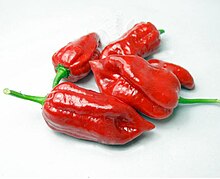
The bell pepper is the fruit of plants in the Grossum Group of the species Capsicum annuum. Cultivars of the plant produce fruits in different colors, including red, yellow, orange, green, white, chocolate, candy cane striped, and purple. Bell peppers are sometimes grouped with less pungent chili varieties as "sweet peppers". While they are fruits—botanically classified as berries—they are commonly used as a vegetable ingredient or side dish. Other varieties of the genus Capsicum are categorized as chili peppers when they are cultivated for their pungency, including some varieties of Capsicum annuum.

Chili peppers, from Nahuatl chīlli, are varieties of the berry-fruit of plants from the genus Capsicum, which are members of the nightshade family Solanaceae, cultivated for their pungency. Chili peppers are widely used in many cuisines as a spice to add "heat" to dishes. Capsaicin and related compounds known as capsaicinoids are the substances giving chili peppers their intensity when ingested or applied topically. While chili peppers are pungent or "spicy", there are other varieties of capsicum such as bell peppers, which generally provide additional sweetness and flavor to a meal rather than “heat.”

Scotch bonnet is a variety of chili pepper named for its supposed resemblance to a Scottish tam o' shanter bonnet. It is ubiquitous in West Africa as well as the Caribbean. Like the closely related habanero, Scotch bonnets have a heat rating of 100,000–350,000 Scoville units. For comparison, most jalapeño peppers have a heat rating of 2,500 to 8,000 on the Scoville scale. However, completely sweet varieties of Scotch bonnet called cachucha peppers are grown on some of the Caribbean islands.

The jalapeño is a medium-sized chili pepper pod type cultivar of the species Capsicum annuum. A mature jalapeño chili is 5–10 cm (2–4 in) long and hangs down with a round, firm, smooth flesh of 25–38 mm wide. It can have a range of pungency, with Scoville heat units of 4,000 to 8,500. Commonly picked and consumed while still green, it is occasionally allowed to fully ripen and turn red, orange, or yellow. It is wider and generally milder than the similar Serrano pepper.

Capsicum annuum var. glabriusculum is a variety of Capsicum annuum that is native to southern North America and northern South America. Common names include chiltepín, Indian pepper, chiltepe, and chile tepín, as well as turkey, bird’s eye, or simply bird peppers, due to their consumption and spread by wild birds, "unlike humans birds are impervious to the heat of peppers". Tepín is derived from a Nahuatl word meaning "flea". This variety is the most likely progenitor of the domesticated C. annuum var. annuum. Another similar-sized pepper, 'Pequin' is often confused with tepin, although the tepin fruit is round to oval where as the pequin's fruit is oval with a point, and the leaves, stems and plant structures are very different on each plant.
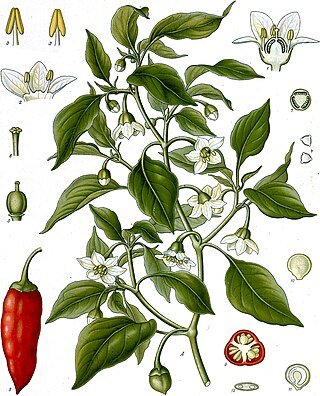
Capsicum annuum is a species of the plant genus Capsicum native to southern North America, the Caribbean, and northern South America. This species is the most common and extensively cultivated of the five domesticated capsicums. The species encompasses a wide variety of shapes and sizes of peppers, including sweet bell peppers and some chili pepper varieties such as jalapeños, New Mexico chile, and cayenne peppers. Cultivars descended from the wild American bird pepper are still found in warmer regions of the Americas. In the past, some woody forms of this species have been called C. frutescens, but the features that were used to distinguish those forms appear in many populations of C. annuum and are not consistently recognizable features in C. frutescens species.

Capsicum chinense, commonly known as a "habanero-type pepper", is a species of chili pepper native to the Americas. C. chinense varieties are well known for their unique flavors and many have exceptional heat. The hottest peppers in the world are members of this species, with Scoville Heat Unit scores of over 2 million. Some taxonomists consider them to be part of the species C. annuum, and they are a member of the C. annuum complex; however, C. chinense and C. annuum pepper plants can sometimes be distinguished by the number of flowers or fruit per node – two to five for C. chinense and one for C. annuum – though this method is not always correct. The two species can also hybridize and generate inter-specific hybrids. It is believed that C. frutescens is the ancestor to the C. chinense species.
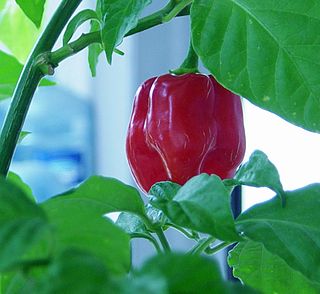
The Red Savina pepper is a cultivar of the habanero chili, which has been selectively bred to produce spicier, heavier, and larger fruit, ultimately more potent than its derivative.

The poblano is a mild chili pepper originating in the state of Puebla, Mexico. Dried, it is called ancho or chile ancho, from the Spanish word ancho ("wide"). Stuffed fresh and roasted it is popular in chiles rellenos poblanos.
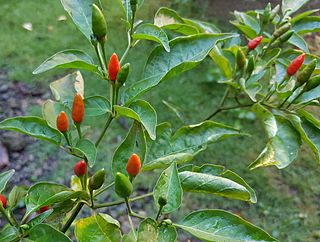
Siling labuyo is a small chili pepper cultivar that developed in the Philippines after the Columbian Exchange. It belongs to the species Capsicum frutescens and is characterized by triangular fruits which grow pointing upwards. The fruits and leaves are used in traditional Philippine cuisine. The fruit is pungent, ranking at 80,000 to 100,000 heat units in the Scoville Scale.

The datil is a very hot pepper, a variety of the species Capsicum chinense.

The Fatalii is a cultivar of the chilli pepper Capsicum chinense developed in southern or central Africa from chilies introduced from the Americas. It is described as having a fruity, citrus flavor with a searing heat comparable to the habanero, to which it is related and from which it may have derived.

The Fresno chile or Fresno chili pepper is a medium-sized cultivar of Capsicum annuum. It should not be confused with the Fresno Bell pepper. It is often confused with the jalapeño pepper but has thinner walls, often has milder heat, and takes less time to mature. It is, however, a Fresno County chile, which is genetically distinct from the jalapeño and it grows point up, rather than point down as with the jalapeño. The fruit starts out bright green changing to orange and red as fully matured. A mature Fresno pepper will be conical in shape, 50 mm (2 in) long, and about 25 mm (1 in) in diameter at the stem. The plants do well in warm to hot temperatures and dry climates with long sunny summer days and cool nights. They are very cold-sensitive and disease resistant, reaching a height of 60–75 cm (24–30 in).

Adjuma, adjoema, aji umba, or ojemma is a variety of Capsicum chinense chili pepper, originally from Brazil. The fruits are shaped like small bell peppers, colored red or yellow. This pepper is sometimes sold as Madame Jeanette, although that is a different variety. Adjuma chilies are also very often sold as "habanero" or "Scotch bonnet", due to their similarity.

Bird's eye chili or Thai chili is a chili pepper, a variety from the species Capsicum annuum native to Mexico. Cultivated across Southeast Asia, it is used extensively in many Asian cuisines. It may be mistaken for a similar-looking chili derived from the species Capsicum frutescens, the cultivar "siling labuyo". Capsicum frutescens fruits are generally smaller and characteristically point upwards.

Capsicum is a genus of flowering plants in the nightshade family Solanaceae, native to the Americas, cultivated worldwide for their chili pepper or bell pepper fruit.

The habanero is a hot variety of chili. Unripe habaneros are green, and they color as they mature. The most common color variants are orange and red, but the fruit may also be white, brown, yellow, green, or purple. Typically, a ripe habanero is 2–6 centimetres long. Habanero chilis are very hot, rated 100,000–350,000 on the Scoville scale. The habanero's heat, flavor and floral aroma make it a popular ingredient in hot sauces and other spicy foods.
The Sandia pepper or Sandia chile pepper is a New Mexico chile pepper cultivar of the species Capsicum annuum with a scoville rating which ranges from mild to hot. This cultivar is extensively grown in New Mexico where it was developed and is popular in New Mexican cuisine. Sandia peppers picked while still green are typically roasted to produce green chile. When ripened, this variety can be dried and ground to make chile powder. Sandia peppers grown and consumed in New Mexico are most commonly used to make red or green posole, green chile stew, and carne adovada.
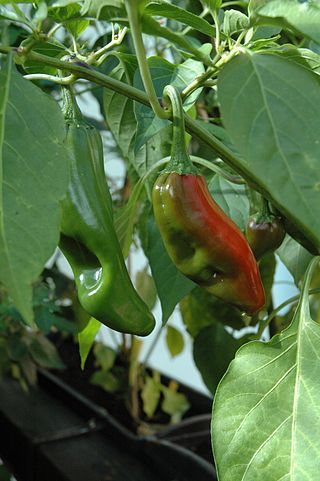
The Big Jim pepper is a New Mexico chile pepper cultivar of the species Capsicum annuum with a Scoville rating of mild. This cultivar is extensively grown in New Mexico where it was developed and is popular in New Mexican cuisine. Big Jim peppers are both sweet and mild and are normally picked while still green. The fruits are large and thick walled, often exceeding over a foot in length, and they are almost exclusively used to produce roasted green chile in New Mexican cuisine.
